Reporting and text: Lindsey Feingold
Page design and graphics: Theresa Phan and Lindsey Feingold
Video and photo: Ryan Sevel, Dani Gillis and Lindsey Feingold
March 28, 2018
GODDARD SPACE FLIGHT CENTER, Maryland -- 40 light years from Earth, a planet that NASA researchers think might be made of diamonds orbits a distant star.
57 light years away, a planet shrouded in pink travels around a star very similar to our own Sun.
And 300 light years away, a planet is being devoured by the star it’s orbiting -- and this isn’t the first planet it’s consumed.
Over the last three decades, space scientists have engaged in a Universe-spanning scavenger hunt, scanning the skies for faint clues to the location of distant worlds called “exoplanets.”
Discovering these planets once seemed an impossible task. But advances in telescope technology, the development of new planet-finding techniques and assistance from humans and powerful computer programs have led to a boom in exoplanet discovery.
Animation by Lindsey Feingold, with Krishnan Vasudevan. Voiceover by Adam Zielonka.
The Earth-like exoplanets mentioned in the video may be habitable for human life, but that cannot be confirmed with current technology.
As a child, astrophysicist Aki Roberge considered the existence of planets trillions and trillions of miles from Earth like something from science fiction.
“Like a lot of NASA people I grew up as a wicked sci-fi fan. Star Trek, Star Wars, all that stuff,” said Roberge, who works in NASA Goddard Space Flight Center’s Exoplanets and Stellar Astrophysics Laboratory. “It’s interesting that a lot of those things we imagined from science fiction turned out to be plausible.”
Since the first discovery in 1992, scientists -- some professional, some amateur -- have found thousands of these planets, including some that could host alien life.
Earlier this month, NASA confirmed the discovery of the 3,706th exoplanet, a world with a mass more than five times as large as Earth orbiting a star called Kepler-1654. And with new, more powerful telescopes on the horizon, the hunt is just getting started.
The First Discoveries
Poltergeist and Phobetor. Those were the names given to the first two exoplanets ever discovered in 1992, situated in the constellation Virgo, more than 2,500 light years from Earth.
Unlike most later discoveries, which would come from data captured by telescopes orbiting the Earth, these two were identified from a ground observatory in Puerto Rico by scientists Aleksander Wolszczan and Dale Frail.
Exoplanet discovery started slowly. The next one was confirmed in 1994, followed by another in 1995. It wasn’t until researchers began to make use of data from the Hubble Telescope -- which was launched in 1990 -- that the pace of discovery sped up.
“Hubble has done so many things it wasn’t designed to do in the first place –- including exoplanet research,” Roberge said.
Most exoplanets discovered in the 1990s were found using data from Hubble and ground-based telescopes -- and a detection technique known as the “radial velocity” method.
To understand how radial velocity works, imagine a police car racing towards you with its siren blaring. As the car approaches, the siren’s pitch is high. As it passes and speeds away, the pitch lowers.
This is called the Doppler effect. Though the police siren example is about soundwaves, there’s a Doppler effect for lightwaves, too. But instead of pitch changing, it's the color of the light that changes, a shift from red to blue.
Astronomers use the Doppler effect to find exoplanets, by training a telescope on a distant star and looking for subtle shifts in light color caused by an exoplanet passing in front of it.
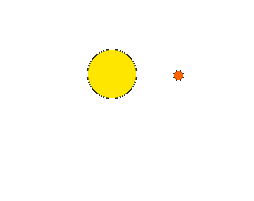
What is happening
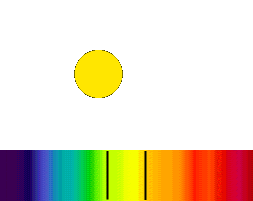
What we see
Gif courtesy of Nick Strobel from Astronomy Notes. Used with permission. Additional editing by Theresa Phan.
A spectrograph, a tool that separates light into its component colors, makes it easier to detect these subtle light changes. The Space Telescope Imaging Spectrograph (STIS) was installed on the Hubble Space Telescope in 1997. A total of 30 exoplanets had been discovered by the year 2000.
The pace of discovery increased following the 2003 launch of a new telescope -- Spitzer -- designed to detect planets in other solar systems by looking for changes in infrared light. It also gave space scientists new tools to measure temperature and atmospheric conditions on the planets.
Using data from Spitzer, Hubble and ground telescopes, scientists had discovered 326 exoplanets by 2009 -- nearly 10 times as many as they'd found at the start of the decade, but still a small number. The 2009 launch of a new telescope called Kepler, tailored specifically to exoplanet discovery, would provide the biggest boost yet.
A New Mission
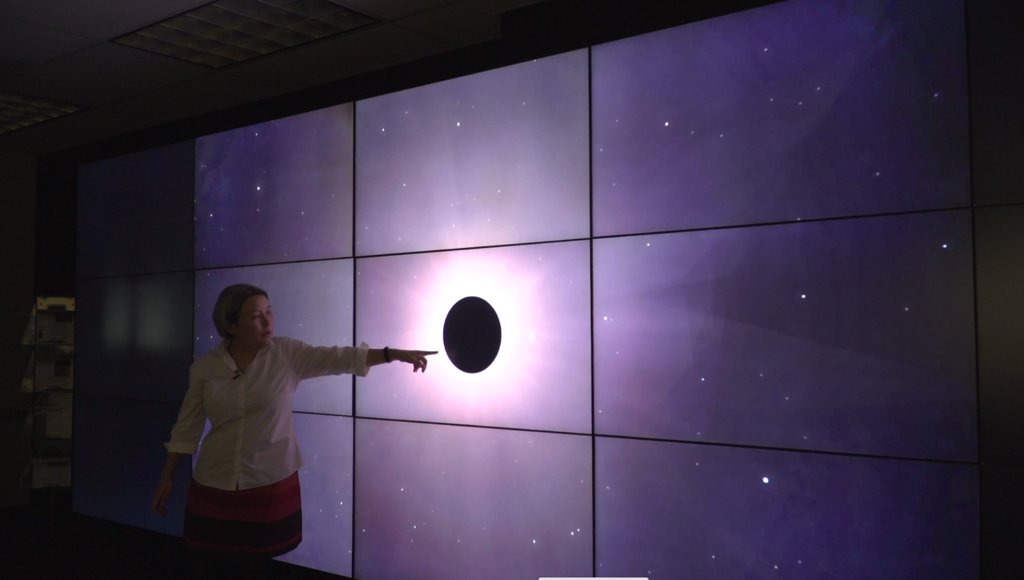
NASA scientist Aki Roberge pointing to a graphic of a planet blocking part of a star. Capital News Service photo by Ryan Sevel.
Kepler was the first NASA mission specifically designed to survey the Milky Way galaxy for exoplanets. The telescope viewed 150,000 stars continuously, gathering images that scientists could use to identify distant planets.
“Kepler was launched to answer one question: how common is a planet like Earth around a star like the sun,” said Padi Boyd, chief of NASA’s Exoplanets and Stellar Astrophysics Laboratory. “The answer we got from Kepler is planets are incredibly common.”
Kepler’s data and advanced technology also made it easier for scientists to rely on another method of planet detection, called the “transit” method. By 2011, this method surpassed radial velocity as the way to discover exoplanets.
Boom in Transit Method of Discovering Exoplanets
Percentage of Planets Discovered by Method

Graphics by Lindsey Feingold. Data from NASA Exoplanet Science Institute. Method percentage data through February 2018.
To understand how the transit method works, think about the solar eclipse that was visible in the United States last summer. The moon passed in front of the sun, temporarily dimming the amount of light that reached Earth.
The same thing happens when we stare at a star in a solar system hundreds of light years away. If an orbiting planet passes between us and the star, the amount of light reaching Earth dims a tiny bit. If we see the same pattern of dimming at a regular interval, it could be evidence of an exoplanet.
“If an astronomy student in a different solar system noticed Earth transiting the Sun, they would have to wait a whole year to see a second transit to confirm that they saw a transit,” said Elizabeth Warner, the director of the University of Maryland Observatory. “If they keep watching they may see Jupiter transiting the sun, but would have to wait 12 years to confirm because that's how long it takes for Jupiter to go around the sun. When we try to find these exoplanets we don't know how long we have to wait to confirm that it was a planet or some random drop in brightness.”
The transit method also offers clues about the size of the planet. The radial velocity method can tell you a planet’s mass. Put size and mass together and you get the density of the planet. Scientists sometimes use both of these methods, and other information, to confirm a potential exoplanet.
Mind-boggling Exoplanet Discoveries
55 Cancri e

Artist’s rendition of 55 Cancri e. Photo Credit: ESA/Hubble via Wikimedia Commons
Initially discovered in 2004, this exoplanet is 40 light years away. One side is in permanent darkness. Some scientists think it is mainly composed of carbon, possibly in the form of diamonds. A 2016 study theorized the planet could be filled with rivers of lava, although later research suggests it has an atmosphere similar to our own planet.
Gliese 436 b

Artist’s rendition of Gliese 436 b. Photo Credit: ESA/Hubble via Wikimedia Commons
Initially discovered in 2004, this exoplanet is just 30 light years away. The Neptune-sized planet has a large cloud that trails behind it in orbit. The strangest feature: it appears to have burning ice under its surface. This is because pressure has caused water beneath the surface to turn to ice and stay solid even with the high temperatures.
HD 149026b
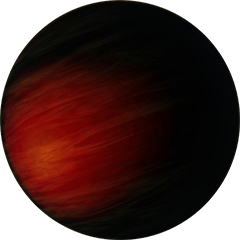
Artist’s concept of HD 149026b. Photo Credit: Wikimedia Commons
Initially discovered in 2005, this exoplanet is about 256 light years away and is so hot –- 3,700 degrees Fahrenheit –- that astronomers believe it is absorbing almost all of the heat from its star. It is reflecting very little light, and it might be the darkest known planet in the Universe.
Hat-P-7b

Artist’s rendition of HAT-P-7b. Photo Credit: Wikimedia Commons
Initially discovered in 2008, this exoplanet is 1,000 light years away. It has clouds likely made from corundum, which is the same mineral that produces rubies and sapphires. It also has winds that blow these clouds across the surface, likely creating violent storms that rain rubies and sapphires.
Kepler-62e

Artist’s rendition of Kepler-62e. Photo Credit: Wikimedia Commons
Initially discovered in 2013, this exoplanet is 1,200 light years away and is roughly 60 percent larger than Earth. It orbits its host star every 122 days and is in the habitable zone. But don’t pack your bags yet –- the surface of the planet is believed to be completely covered in water.
Kepler-78b

Artist’s rendition of Kepler-78b. Photo Credit: Wikimedia Commons
Initially discovered in 2013, this exoplanet is 700 light years away and orbits its star in just about 8.5 hours. A lava world, scientists aren’t sure how this planet exists. There's no known physical way this small of a planet could have evolved so close to its host star, and there's no known mechanism that could have transported it there.
Gliese 504 b

Artist’s rendition of Gliese 504 b. Photo Credit: Wikimedia Commons
Initially discovered in 2013, this exoplanet is about 57 light years away. It is about 160 million years old, relatively young. The newly formed planet glows from the heat generated during formation, which makes it appear as a pink or magenta color.
Kepler-1647b
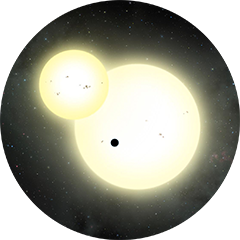
Artist's rendition of Kepler-1647. Photo Credit: Lynette Cook/NASA
Initially discovered in 2016, this exoplanet is 3,700 light years away and is roughly as old as the Earth. This planet orbits multiple suns, like Tatooine from Star Wars. It is also in the habitable zone, so it might potentially be able to support life.
Some Surprising Help
Just two years after Kepler launched, the number of confirmed exoplanets had more than doubled to 655. By then, professional scientists weren’t the only ones investigating the Kepler data. They also had help from a growing network of amateur scientists. Planet Hunters, a project created in 2010, allows anyone to sift through Kepler data to find exoplanets.
Over 300,000 people have done so, helping to find a few thousand exoplanets over the last seven years. The kicker: about 100 of these findings were completely missed by NASA.
While the NASA Kepler team has created a pipeline of automated detection algorithms to go through the data, “there will be planets which can only be found via the innate human ability for pattern recognition,” according to the Planet Hunters website.
“The Kepler Pipeline is great at finding exoplanets with orbits from a day to 100 days, but then its efficiency falls off dramatically,” said Debra Fischer, an astronomy professor at Yale University and one of the founders of Planet Hunters. “We are providing something really unique that would have been completely missed otherwise.”
Citizen Science Takes Exoplanet Discoveries to New Level
COLLEGE PARK, Maryland -- While scientists at NASA were leaping with joy when the first Earth-size exoplanet was discovered in 2011, two 14-year-old twins were taking part in a mission of their own using data from the Kepler Space Telescope.
Working out of their home on an eastern Connecticut farm, Jennifer Kahn and Rebekah Kahn used their personal computer to sift through images from Kepler looking for light curves that would signal the presence of an exoplanet.
The images were delivered on a website called Planet Hunters, a crowdsourced citizen scientist network launched in 2010 that allows anyone to help in the hunt for exoplanets. More than 300,000 people have helped find a few thousand exoplanets over the last seven years.
Read more...
The Kahn twins, who were some of the first members of Planet Hunters, credit the project with driving them towards careers in astronomy. Both of them are currently undergraduate astronomy majors and geoscience minors at Smith College and last summer were paid research interns at the NASA Ames Research Center.
“Planet Hunters gave us our first chance to do ‘real’ science…the search for other worlds and other life is one of humankind’s greatest quests and so it’s really more like an adventure that we would like to take part in,” they wrote in an email.
Debra Fischer, an astronomy professor at Yale University and one of the founders of Planet Hunters, estimated that at least 50 planet hunter volunteers have been credited with discovering an exoplanet.
The first person to identify a transit dip for a potential exoplanet is credited as a co-author on a scientific paper about the discovery. For a transit dip to be flagged in the system, between three and 10 people have to identify the dip. Other individuals who identify the transit or contribute substantially to the discovery of the transit, such as modeling it, might also be a co-author on the paper as well.
“I think citizen science in general, this idea of getting more people excited and feeling a part of the mission that NASA is doing, is critical,” said Avi Mandell, a research scientist at NASA. “Everyone has a computer and everyone can look at pictures and understand what we are trying to do.”
Planet Hunters isn’t the only website that allows people without a background in astronomy to participate.
Zooniverse has also sponsored two NASA-funded citizen science projects. Backyard Worlds: Planet 9 allows people to join the search by viewing brief movies made from images captured by NASA's Wide-field Infrared Survey Explorer telescope. And Exoplanet Explorers asks volunteers to look through Kepler data for traces of exoplanets, similar to Planet Hunters.
The Exoplanet Explorers team partnered with an Australian TV show, ABC Stargazing Live, to broadcast this project live for three nights in April during prime time. The result: over 1 million viewers watched the show and more than 14,000 volunteers classified over 2 million points of interest on the website in just three days.
An Australian car mechanic found a new four-planet solar system and will have his name appear in a scientific paper on the discovery.
Geert Barentsen, a research scientist at NASA’s Ames Research Center and part of a team tasked with helping scientists make use of the data from Kepler, said there is a need for multiple citizen scientist websites involving exoplanets because the amount of data scientists are collecting is increasing rapidly.
“By sharing the general thrill of scientific discovery with everyone, that has highly built public support for exoplanet research,” he said. “There is more data than ever before so we are going to need more and more citizens to verify data sets...and these websites are really going to help us get more people excited about that.”
Hide story...
Citizen Science Takes Exoplanet Discoveries to New Level
COLLEGE PARK, Maryland -- While scientists at NASA were leaping with joy when the first Earth-size exoplanet was discovered in 2011, two 14-year-old twins were taking part in a mission of their own using data from the Kepler Space Telescope.
Working out of their home on an eastern Connecticut farm, Jennifer Kahn and Rebekah Kahn used their personal computer to sift through images from Kepler looking for light curves that would signal the presence of an exoplanet.
The images were delivered on a website called Planet Hunters, a crowdsourced citizen scientist network launched in 2010 that allows anyone to help in the hunt for exoplanets. More than 300,000 people have helped find a few thousand exoplanets over the last seven years.
The Kahn twins, who were some of the first members of Planet Hunters, credit the project with driving them towards careers in astronomy. Both of them are currently undergraduate astronomy majors and geoscience minors at Smith College and last summer were paid research interns at the NASA Ames Research Center.
“Planet Hunters gave us our first chance to do ‘real’ science…the search for other worlds and other life is one of humankind’s greatest quests and so it’s really more like an adventure that we would like to take part in,” they wrote in an email.
Debra Fischer, an astronomy professor at Yale University and one of the founders of Planet Hunters, estimated that at least 50 planet hunter volunteers have been credited with discovering an exoplanet.
The first person to identify a transit dip for a potential exoplanet is credited as a co-author on a scientific paper about the discovery. For a transit dip to be flagged in the system, between three and 10 people have to identify the dip. That depends on the weighting of each person in the system who identifies the transit, which is determined by how many contributions they have made, among other factors. Other individuals who identify the transit or contribute substantially to the discovery of the transit, such as modeling it, might also be a co-author on the paper as well.
“I think citizen science in general, this idea of getting more people excited and feeling a part of the mission that NASA is doing, is critical,” said Avi Mandell, a research scientist at NASA. “Everyone has a computer and everyone can look at pictures and understand what we are trying to do.”
Planet Hunters isn’t the only website that allows people without a background in astronomy to participate.
Zooniverse has also sponsored two NASA-funded citizen science projects. Backyard Worlds: Planet 9 allows people to join the search by viewing brief movies made from images captured by NASA's Wide-field Infrared Survey Explorer telescope. And Exoplanet Explorers asks volunteers to look through Kepler data for traces of exoplanets, similar to Planet Hunters.
The Exoplanet Explorers team partnered with an Australian TV show, ABC Stargazing Live, to broadcast this project live for three nights in April during prime time. The result: over 1 million viewers watched the show and more than 14,000 volunteers classified over 2 million points of interest on the website in just three days.
An Australian car mechanic found a new four-planet solar system and will have his name appear in a scientific paper on the discovery.
Geert Barentsen, a research scientist at NASA’s Ames Research Center and part of a team tasked with helping scientists make use of the data from Kepler, said there is a need for multiple citizen scientist websites involving exoplanets because the amount of data scientists are collecting is increasing rapidly.
“By sharing the general thrill of scientific discovery with everyone, that has highly built public support for exoplanet research,” he said. “There is more data than ever before so we are going to need more and more citizens to verify data sets...and these websites are really going to help us get more people excited about that.”
They’ve also been assisted by artificial intelligence. A senior software engineer with Google’s research team Google AI came up with the idea to apply a neural network -- a computer system modeled on the human brain and nervous system -- to Kepler data. This led to the discovery of multiple unknown exoplanets, NASA said in a December 2017 press release.
As the pace of discovery quickens, scientists have sharpened their focus on finding “habitable” planets that could sustain life, like Ross 128 b, a planet 11 light years from Earth, discovered by Chilean scientists. It is believed to be the Earth-sized planet closest to Earth that could sustain life.
What makes an exoplanet a candidate to sustain life? The distance it sits from its star is one clue. If a planet is too close, surface temperatures could be too hot to sustain life. If a planet is too far away, the temperatures could be too low. Planets in the so-called “habitable zone” have a Goldilocks-esque not-too-hot, not-too-cold temperature, like Earth. And then it has to have liquid water -- a key ingredient in the development of life -- and an atmosphere, Roberge said.
A Mission Hurdle
By 2013, with 792 confirmed discoveries, it was clear that Kelper had a dramatic effect on exoplanet discovery. But then the mission hit a snag.
Kepler lost two of the four wheels used to position it -- and its ability to stay pointed at a target without drifting off course. For four years, Kepler had been focused on one particular set of stars in the Milky Way, gathering huge amounts of data. The wheel malfunction meant it would be impossible to fix Kepler’s gaze on that same star field.
“Scientists at NASA knew as soon as they realized the second wheel had failed that they would never be able to maintain a fine pointing on the original field,” Boyd said.
So NASA, Ball Aerospace engineers and the rest of the scientific community pivoted. They found a way to continue to gather data from Kepler, looking at more areas of the sky, but for shorter stretches of time. That mission was called K2.
“K2 gave scientists a much broader reach with the stars they could observe and it was sort of like bringing a new mission out of the ashes of the old,” Boyd said. “They would have gotten a lot of great science if they stayed in the original Kepler field…but now they can go to different parts of the sky and study different populations of stars in our galaxy.”
The discoveries continued to roll in. Nearing the end of March 2018, about 3,700 exoplanets have been verified to date. And there are reasons to think the numbers will continue to grow.
Future Missions
Scientists at NASA are currently gearing up to launch The Transiting Exoplanet Survey Satellite, otherwise known as TESS, no earlier than April 16, 2018. Its main mission: to detect small, hard-to-detect planets with bright host stars in the solar neighborhood. It will monitor the brightness of more than 500,000 stars, which will help scientists use the transit method to identify exoplanets. TESS is expected to categorize 3,000 exoplanet candidates –- including around 500 planets the same size as Earth, or a little bit bigger.
Two years later, NASA expects to launch what it calls “the premier observatory of the next decade,” the James Webb Space Telescope. The infrared telescope will partly study the atmospheres of exoplanets, using the transit method, and increase the viability of a newer method of exoplanet detection -- “direct imaging.”
“If you think back hundreds of years ago planets in the solar system were just blobs to us, but roughly a century ago we started being able to see the surfaces of some of them,” Roberge said. “We want to be able to do for exoplanets what was done for [planets in our] solar system. The next step is actually being able to see exoplanets as little blobs.”
The transit method and the radial velocity method both provide clues to the existence of a planet, without offering a picture of one. Direct imaging does exactly that.
But it’s extremely difficult to take a picture of an exoplanet, because the stars they orbit are so much brighter.
“A star is a billion times brighter than the light from the planet and in that sense it’s almost like looking for a firefly in a spotlight,” said Avi Mandell, a civil servant research scientist in the Planetary Systems Laboratory for NASA.
To capture an exoplanet image, scientists have to block the light from the distant stars, and the Webb telescope will have technology to help do that. Webb will carry coronagraphs to enable direct imaging of giant exoplanets orbiting nearby stars.
“If you remove the light from the star and you can see the planet, you can do all these wonderful things like find what the atmosphere is made of and eventually look for signs of life on a planet,” Stephen Rinehart, a senior astrophysicist at NASA, said.
However, the primary way Webb will study exoplanets is through transit spectroscopy.
Beyond Webb, scientists are anxiously anticipating the Wide Field Infrared Survey Telescope, otherwise known as WFIRST. Designed to investigate the nature of dark energy and study exoplanets, this mission is scheduled to launch in the mid-2020s.
WFIRST will be the most sensitive telescope ever launched into space, with 100 times the field of view as Hubble.
We Went to NASA to Learn More About WFIRST
Capital News Service video by Ryan Sevel and Dani Gillis. Watch a behind-the-scenes video here
The telescope will have a serviceability design, meaning different instruments can be put in and taken out throughout its lifespan. It will be compatible with a star shade, a separate spacecraft from WFIRST that can be stationed at a distance from the telescope to block out starlight. While the star shade isn’t part of the mission as of now, it could potentially be added at a later date, Mandell said.
Some “planets aren’t bright enough to be seen by James Webb,” Mandell said. “WFIRST will push that to be 1,000 times better than James Webb.”
One year after NASA approved the project, the projected cost has risen to $3.6 billion, which is about 10 percent over budget. In October 2017, WFIRST underwent an independent external technical, management and cost review, resulting in some adjustments to the mission and cost reductions. According to the NASA website, it is still on track for a mid-2020s launch, even though President Donald Trump’s recent budget proposal called for cancelling the mission. Congress, in approving a budget that President Trump signed last week, ignored the cancellation request and included continued funding for WFIRST in Fiscal Year 2018.
Mandell said NASA planned to do a much more capable mission, but that had to be scaled back due to budget constraints.
“Budget is always a hard problem with missions because it always ends up costing more to do what you originally planned to do,” Mandell said.
In the future, if this project moves forward, scientists hope WFIRST will help actually find life on these potentially habitable exoplanets.
“What we want to do is build a facility that can really access planets like the Earth and tell us okay we see it’s Earth size, but is it Earth like? That’s a question we currently don’t know the answer to,” Roberge said.
And one day -- years from now, with much more advanced technology -- humans could travel to these alien worlds, said Michael McElwain, James Webb Space Telescope Observatory Project Scientist at NASA.
“After we find planets similar to Earth and exhaustively observe their atmospheres remotely, the next step will be to plan how we can send a satellite there for close-up observations,” McElwain said. “One day humanity will go to explore these distant places, but first we need to focus on discovering nearby habitable planets and then searching for biosignatures. And that all starts with the space telescopes we are developing now.”



